Bird R.B., Stewart W.E., Lightfoot E.N. Transport Phenomena
Подождите немного. Документ загружается.

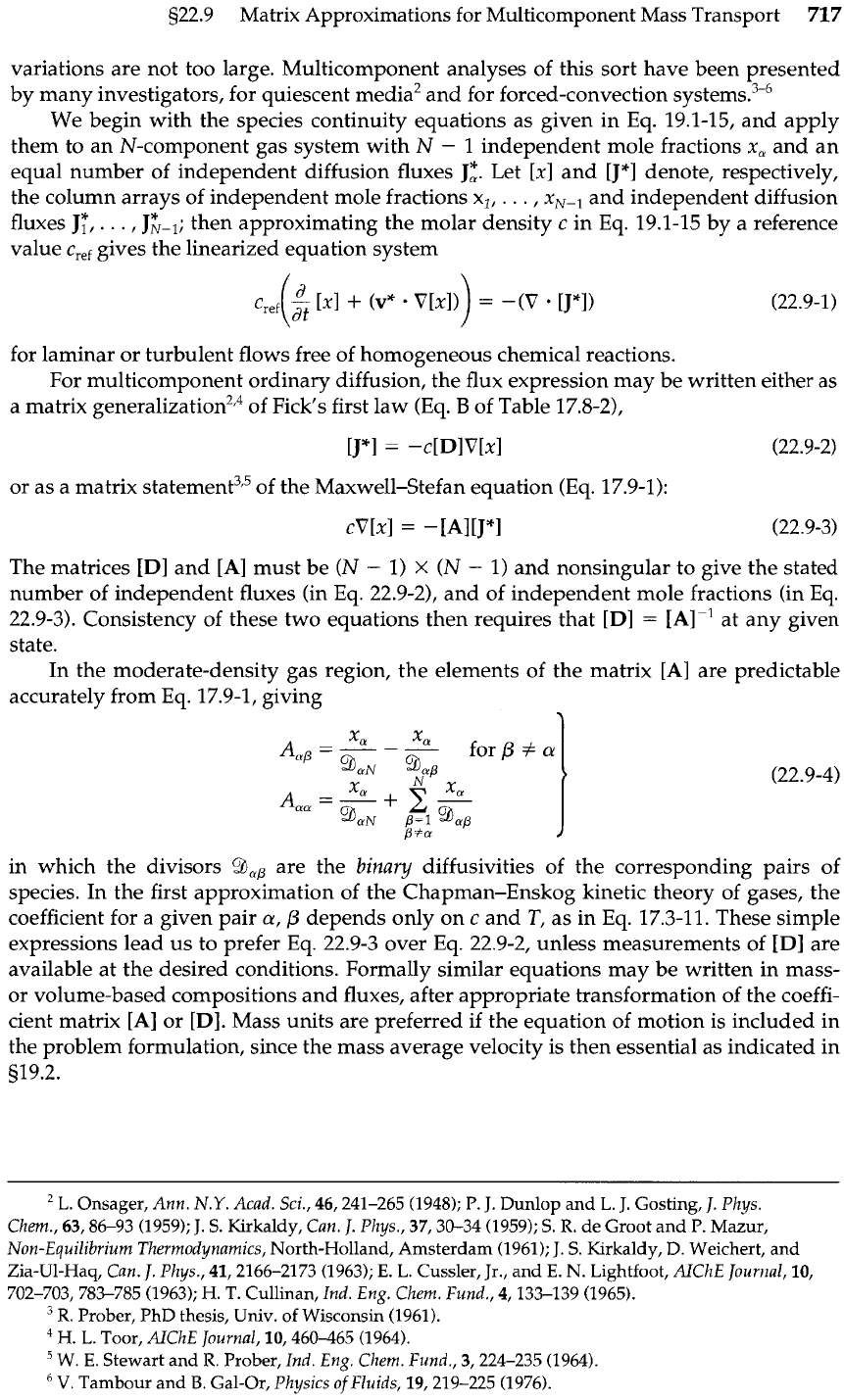
s22.9 Matrix Approximations for Multicomponent Mass Transport
717
variations are not too large. Multicomponent analyses of this sort have been presented
by many investigators, for quiescent media2 and for forced-convection systems."'
We begin with the species continuity equations as given in Eq. 19.1-15, and apply
them to an N-component gas system with N
-
1 independent mole fractions
x,
and an
equal number of independent diffusion fluxes
J:.
Let
[XI
and
[J"]
denote, respectively,
the column arrays of independent mole fractions x,,
. .
.
,
x,-,
and independent diffusion
fluxes
J:,
.
.
.
,
JG-,;
then approximating the molar density
c
in Eq. 19.1-15 by a reference
value
c,,,
gives the linearized equation system
for laminar or turbulent flows free of homogeneous chemical reactions.
For multicomponent ordinary diffusion, the flux expression may be written either as
a matrix generalization2f4 of Fick's first law (Eq.
B
of Table 17.8-2),
or as a matrix statement3t5 of the Maxwell-Stefan equation (Eq. 17.9-1):
The matrices
[Dl
and
[A]
must be (N
-
1)
X
(N
-
1) and nonsingular to give the stated
number of independent fluxes (in Eq. 22.9-2), and of independent mole fractions (in
Eq.
22.9-3). Consistency of these two equations then requires that
[Dl
=
[Alp'
at any given
state.
In the moderate-density gas region, the elements of the matrix
[A]
are predictable
accurately from Eq. 17.9-1, giving
in which the divisors
BOP
are the
binary
diffusivities of the corresponding pairs of
species. In the first approximation of the Chapman-Enskog kinetic theory of gases, the
coefficient for a given pair a,
p
depends only on
c
and
T,
as in Eq. 17.3-11. These simple
expressions lead us to prefer Eq. 22.9-3 over Eq. 22.9-2, unless measurements of
[Dl
are
available at the desired conditions. Formally similar equations may be written in mass-
or volume-based compositions and fluxes, after appropriate transformation of the coeffi-
cient matrix
[A]
or
[Dl.
Mass units are preferred if the equation of motion is included in
the problem formulation, since the mass average velocity is then essential as indicated in
919.2.
L.
Onsager,
Ann.
N.Y.
Acad. Sci.,
46,241-265 (1948);
P.
J.
Dunlop and
L.
J. Gosting,
J.
Phys.
Chem.,
63,86-93 (1959);
J.
S.
Kirkaldy,
Can.
J.
Phys.,
37,30-34 (1959);
S.
R.
de Groot and
P.
Mazur,
Non-Equilibrium Thermodynamics,
North-Holland, Amsterdam
(1961);
J.
S.
Kirkaldy, D. Weichert, and
Zia-U1-Haq,
Can.
J.
Phys.,
41,2166-2173 (1963);
E.
L.
Cussler, Jr., and
E.
N.
Lightfoot,
AKhE Journal,
10,
702-703,783-785 (1963);
H. T. Cullinan,
Ind. Eng. Chem. Fund.,
4,133-139 (1965).
R.
Prober, PhD thesis, Univ. of Wisconsin
(1961).
H.
L.
Toor,
AKhE
Journal,
10,460465 (1964).
W.
E.
Stewart and
R.
Prober,
Ind. Eng. Chem. Fund.,
3,224-235 (1964).
9,
Tambour and
B.
Gal-Or,
Physics of Fluids,
19,219-225 (1976).
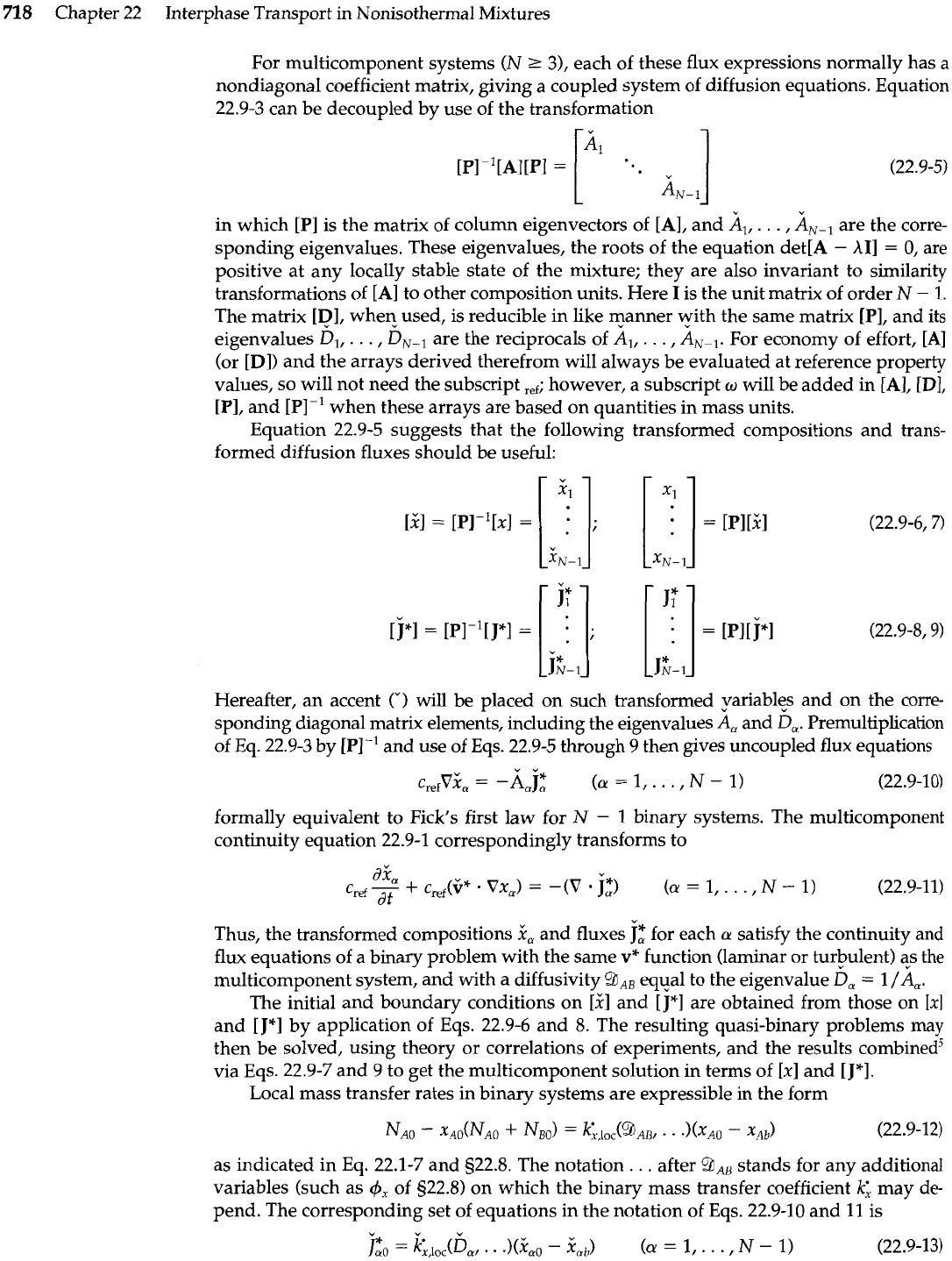
718
Chapter
22
Interphase Transport in Nonisothermal Mixtures
For multicomponent systems (N
2
31, each of these flux expressions normally has a
nondiagonal coefficient matrix, giving a coupled system of diffusion equations. Equation
22.9-3 can be decoupled by use of the transformation
[PI -'[A] [PI
=
["
.
v
]
(22.9-5)
AN-
1
" "
in which [PI is the matrix of column eigenvectors of [A], and A,,
. .
.
,
A,-,
are the corre-
sponding eigenvalues. These eigenvalues, the roots of the equation det[A
-
A11
=
0,
are
positive at any locally stable state of the mixture; they are also invariant to similarity
transformations of [A] to other composition units. Here
I
is the unit matrix of order
N
-
1.
The matrix [Dl, when used, is reducible in like manner with the same matrix [PI, and its
eigenvalues Dl,
.
. .
,
DN-, are the reciprocals of A,,
.
.
.
,
AN-,. For economy of effort, [A]
(or
[Dl)
and the arrays derived therefrom will always be evaluated at reference property
values, so will not need the subscript
,,*;
however, a subscript
w
will be added in [A],
[Dl,
[PI, and [PI-' when these arrays are based on quantities in mass units.
Equation 22.9-5 suggests that the following transformed compositions and trans-
formed diffusion fluxes should be useful:
Hereafter, an accent
(')
will
be placed on such transformed yariabks and on the corre-
sponding diagonal matrix elements, including the eigenvalues
A,
and D,. Premultiplication
of
Eq.
22.9-3 by [PI-' and use of Eqs. 22.9-5 through 9 then gives uncoupled flux equations
formally equivalent to Fick's first law for
N
-
1
binary systems. The multicomponent
continuity equation 22.9-1 correspondingly transforms to
Thus, the transformed compositions
%a
and fluxes
j:
for each
a
satisfy the continuity and
flux equations of a binary problem with the same
v"
function (laminar or turbulent) as the
multicomponent system, and with a diffusivity
91AB
equal to the eigenvalue
D,
=
1
/A,.
The initial and boundary conditions on [?I and [j'] are obtained from those on
1x1
and
[
J"1 by application of Eqs. 22.9-6 and
8.
The resulting quasi-binary problems may
then be solved, using theory or correlations of experiments, and the results combined5
via Eqs. 22.9-7 and 9 to get the multicomponent solution in terms of [XI and
[
J"].
Local mass transfer rates in binary systems are expressible in the form
as indicated in Eq. 22.1-7 and s22.8. The notation
. .
.
after
9,,
stands for any additional
variables (such as
4,
of 922.8) on which the binary mass transfer coefficient
k;
may de-
pend. The corresponding set of equations in the notation of Eqs. 22.9-10 and
11
is
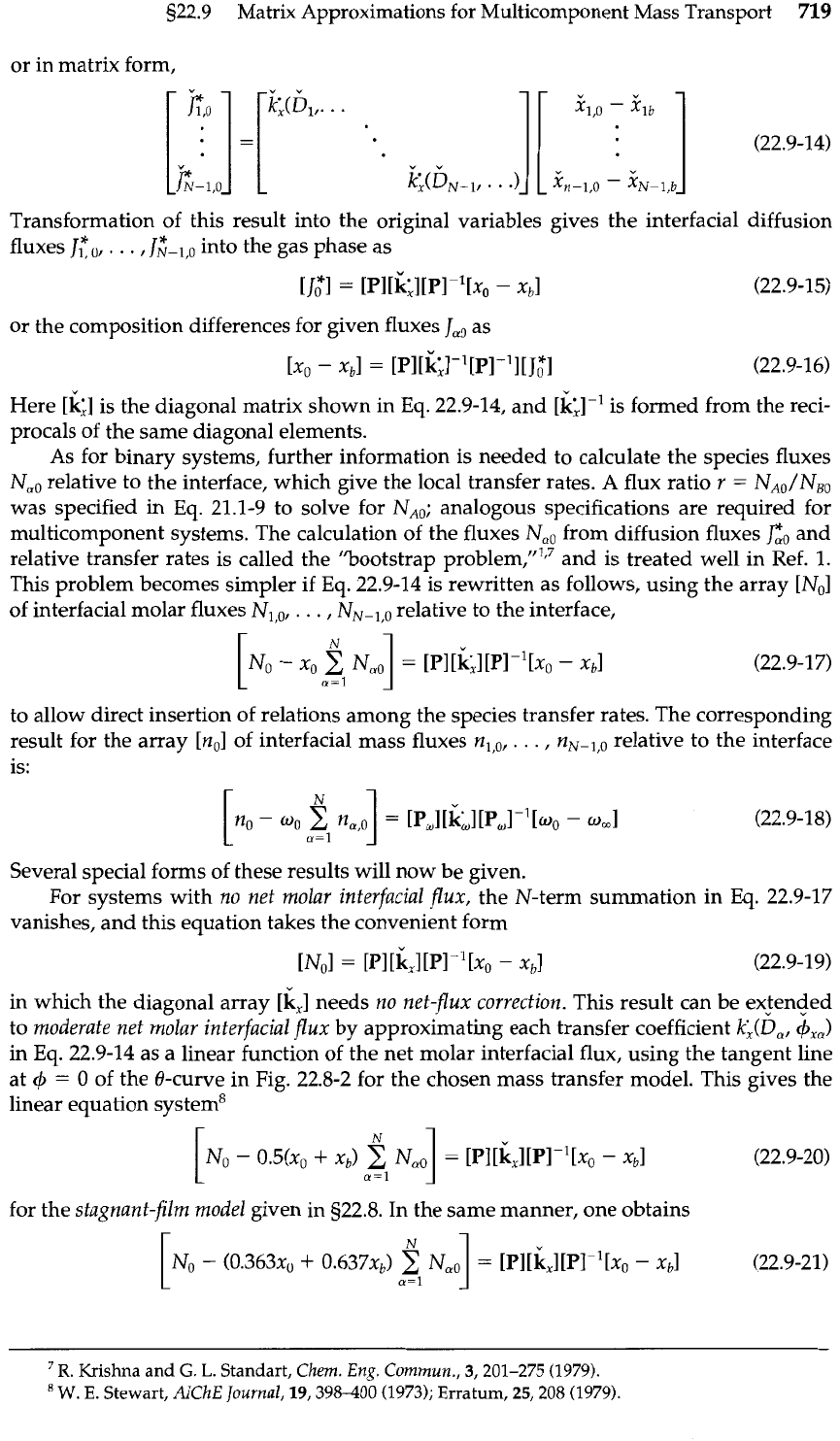
522.9 Matrix Approximations for Multicomponent Mass Transport
719
or in matrix form,
Transformation of this result into the original variables gives the interfacial diffusion
fluxes
J:,,
.
.
.
,
J&,,,
into the gas phase as
or the composition differences for given fluxes Jao as
Here
[kl
is the diagonal matrix shown in Eq. 22.9-14, and
[h-'
is formed from the reci-
procals of the same diagonal elements.
As for binary systems, further information is needed to calculate the species fluxes
N,, relative to the interface, which give the local transfer rates.
A
flux ratio r
=
NAo/NBo
was specified in Eq.
21.1-9
to solve for N,,; analogous specifications are required for
multicomponent systems. The calculation of the fluxes N,, from diffusion fluxes
co
and
relative transfer rates is called the "bootstrap problem,"',7 and is treated well in Ref. 1.
This problem becomes simpler if Eq. 22.9-14 is rewritten as follows, using the array [No]
of interfacial molar fluxes N,,,,
. .
.
,
NN-l,O relative to the interface,
to allow direct insertion of relations among the species transfer rates. The corresponding
result for the array [no] of interfacial mass fluxes n,,,,
. . .
,
n,-,,, relative to the interface
is:
Several special forms of these results will now be given.
For systems with no net molar interfacial flux, the N-term summation in Eq. 22.9-17
vanishes, and this equation takes the convenient form
in which the diagonal array [k] needs no net-flux correction. This result can be extended
to moderate net molar interfacial flux by approximating each transfer coefficient kx(Da,
$,,I
in Eq. 22.9-14 as a linear function of the net molar interfacial flux, using the tangent line
at
4
=
0
of the 8-curve in Fig. 22.8-2 for the chosen mass transfer model. This gives the
linear equation system8
for the stagnant-film model given in 322.8. In the same manner, one obtains
'
R.
Krishna and
G.
L.
Standart,
Chem.
Eng.
Commun.,
3,201-275
(1979).
W.
E.
Stewart,
AlChE Journal,
19,398400 (1973); Erratum, 25,208 (1979).
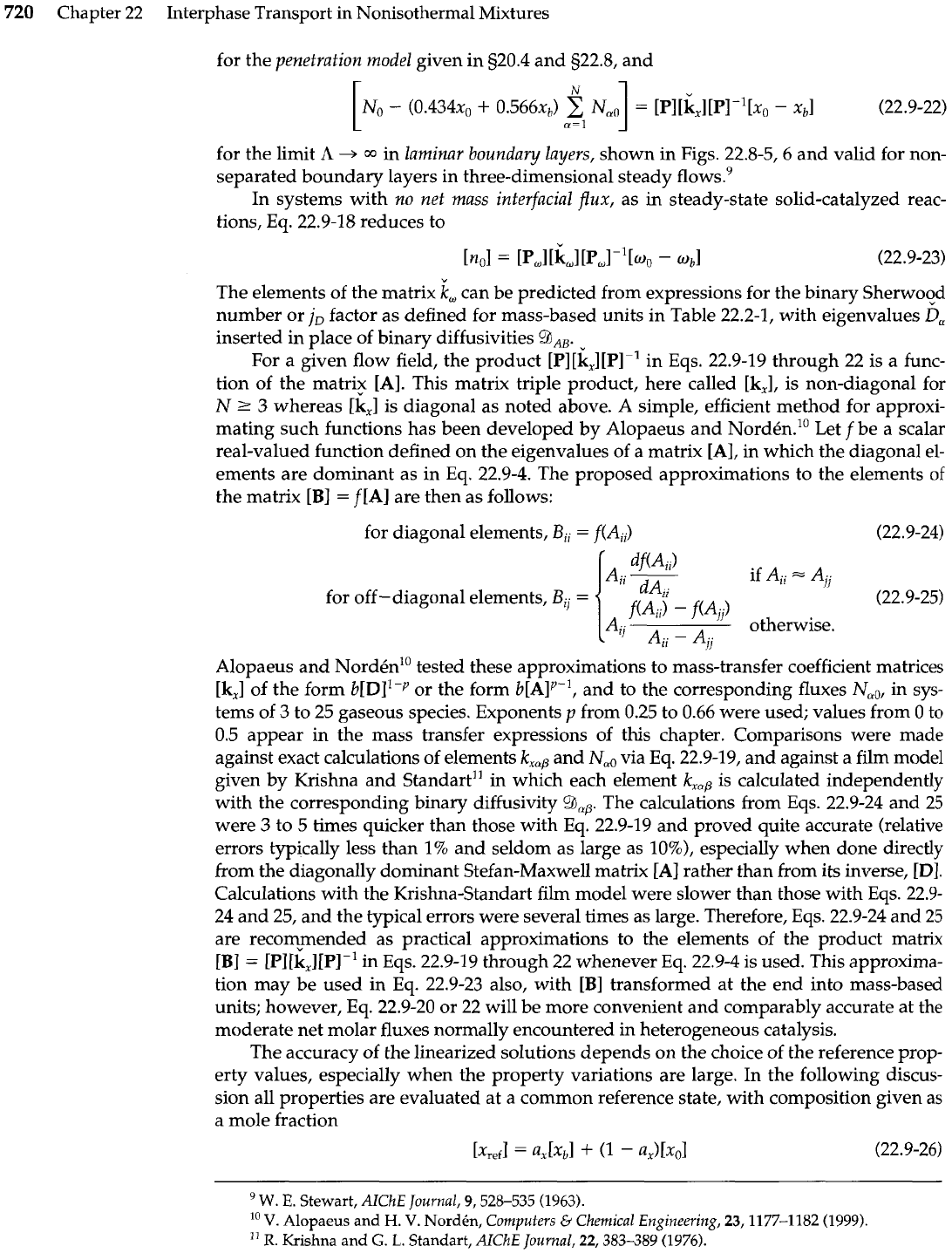
720
Chapter 22 Interphase Transport in Nonisothermal Mixtures
for the penetration model given in g20.4 and 522.8, and
for the limit
A
+
w
in laminar boundary layers, shown in Figs. 22.8-5,6 and valid for non-
separated boundary layers in three-dimensional steady flows.9
In systems with
no
net mass interfacial pux, as
in
steady-state solid-catalyzed reac-
tions, Eq. 22.9-18 reduces to
The elements of the matrix
$
can be predicted from expressions for the binary Sherwood
number or
j,
factor as defined for mass-based units in Table 22.2-1, with eigenvalues
fim
inserted in place of binary diffusivities
a,,.
For a given flow field, the product [~][k,l[~l~' in Eqs. 22.9-19 through 22 is a func-
tion of the matrix [A]. This matrix triple product, here called [k,], is non-diagonal for
N
r
3
whereas [kl is diagonal as noted above. A simple, efficient method for approxi-
mating such functions has been developed by Alopaeus and Nord6n.lo Let f be a scalar
real-valued function defined on the eigenvalues of a matrix [A], in which the diagonal el-
ements are dominant as in Eq. 22.9-4. The proposed approximations to the elements of
the matrix [B]
=
f
[A] are then as follows:
for diagonal elements,
Bii
=
f(Aii)
(22.9-24)
df(Aii)
A"
d~,
if
A~~
=
A~~
for off-diagonal elements, Bij
=
f(AJ
-
f(Aji)
(22.9-25)
Aij
A-A,.
otherwise.
"
I1
Alopaeus and Nordenlo tested these approximations to mass-transfer coefficient matrices
[k,] of the form b[DI1-P or the form b[AlP-', and to the corresponding fluxes N,,, in sys-
tems of 3 to 25 gaseous species. Exponents
p
from 0.25 to 0.66 were used; values from 0 to
0.5 appear in the mass transfer expressions of this chapter. Comparisons were made
against exact calculations of elements
kxap
and
N,,
via Eq. 22.9-19, and against a film model
given by Krishna and Standart" in which each element
kXop
is calculated independently
with the corresponding binary diffusivity
gap.
The calculations from Eqs. 22.9-24 and 25
were
3
to
5
times quicker than those with Eq. 22.9-19 and proved quite accurate (relative
errors typically less than 1% and seldom as large as
lo%),
especially when done directly
from the diagonally dominant Stefan-Maxwell matrix [A] rather than from its inverse,
[Dl.
Calculations with the Krishna-Standart film model were slower than those with Eqs. 22.9-
24 and 25, and the typical errors were several times as large. Therefore, Eqs. 22.9-24 and 25
are recommended as practical approximations to the elements of the product matrix
[B]
=
[~l[k,][P]-' in Eqs. 22.9-19 through 22 whenever
Eq.
22.9-4 is used. This approxima-
tion may be used in Eq. 22.9-23 also, with [Bl transformed at the end into mass-based
units; however, Eq. 22.9-20 or 22 will be more convenient and comparably accurate at the
moderate net molar fluxes normally encountered in heterogeneous catalysis.
The accuracy of the linearized solutions depends on the choice of the reference prop-
erty values, especially when the property variations are large. In the following discus-
sion all properties are evaluated at a common reference state, with composition given
as
a mole fraction
[xref1
=
a,[xb1
+
(1
-
a,)[xol
(22.9-26)
W.
E.
Stewart,
AlChE
Jouvnal,
9,528-535 (1963).
lo
V.
Alopaeus and
H.
V.
Norden,
Computers
O.
Chemical Engineering,
23,1177-1182 (1999).
"
R.
Krishna and
G.
L.
Standart,
MChE
Journal,
22,383-389 (1976).
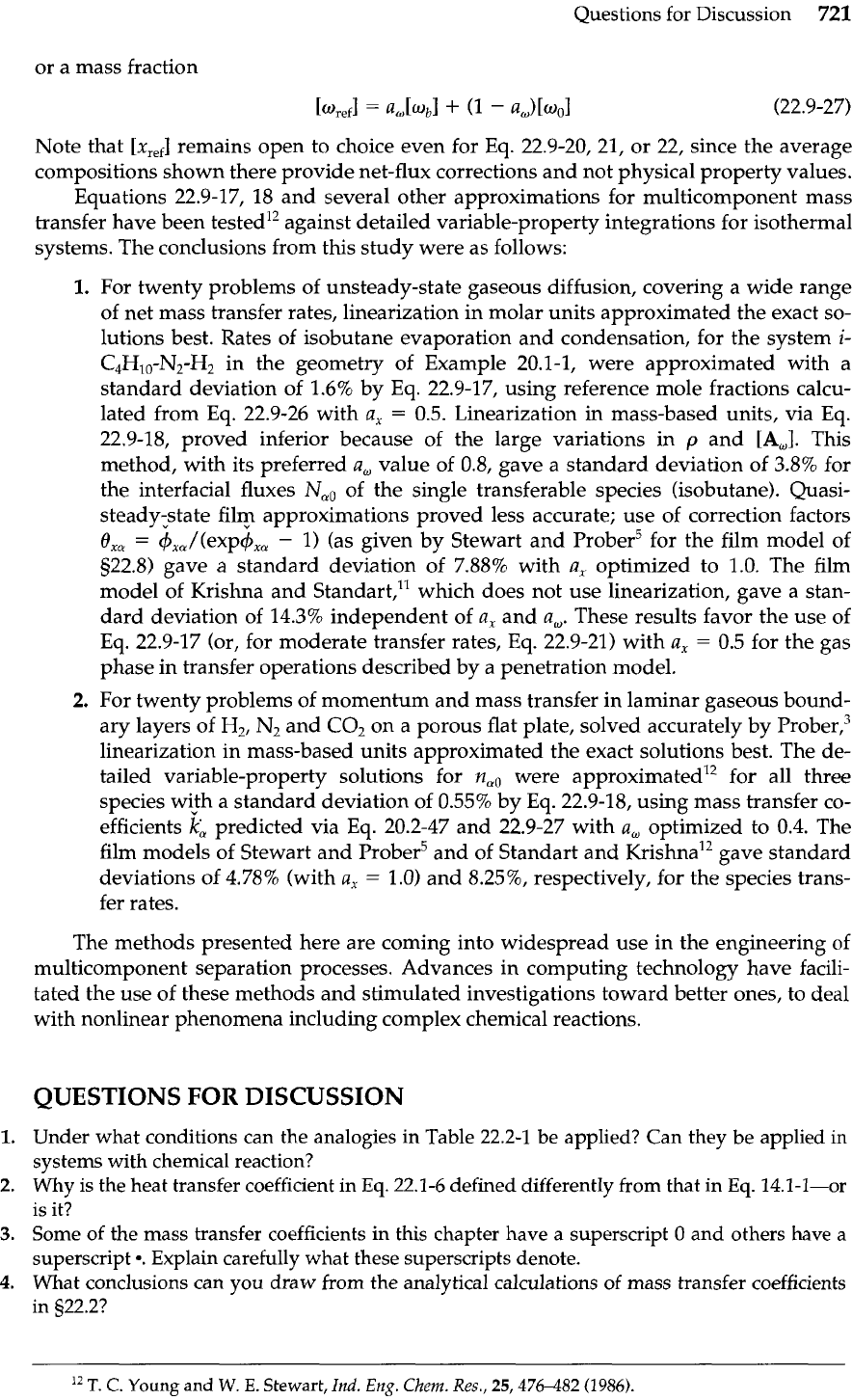
Questions for Discussion
721
or a mass fraction
[wref1
=
ao[mb1
+
(1
-
a,)[w,I
(22.9-27)
Note that
[x,,,]
remains open to choice even for Eq. 22.9-20, 21, or 22, since the average
compositions shown there provide net-flux corrections and not physical property values.
Equations 22.9-17, 18 and several other approximations for multicomponent mass
transfer have been tested" against detailed variable-property integrations for isothermal
systems. The conclusions from this study were as follows:
For twenty problems of unsteady-state gaseous diffusion, covering a wide range
of net mass transfer rates, linearization in molar units approximated the exact so-
lutions best. Rates of isobutane evaporation and condensation, for the system
i-
C4H,,-N2-H,
in the geometry of Example 20.1-1, were approximated with a
standard deviation of 1.6% by Eq. 22.9-17, using reference mole fractions calcu-
lated from Eq. 22.9-26 with
a,
=
0.5. Linearization in mass-based units, via Eq.
22.9-18, proved inferior because of the large variations in
p
and
[A,].
This
method, with its preferred
a,
value of 0.8, gave a standard deviation of 3.8% for
the interfacial fluxes
N,,
of the single transferable species (isobutane). Quasi-
steady-state film approximations proved less accurate; use of correction factors
Ox,
=
$,,/(exp$,,
-
1)
(as given by Stewart and Prober5 for the film model of
522.8)
gave
a
standard deviation of 7.88% with
n,
optimized to 1.0. The film
model of Krishna and Standart,'' which does not use linearization, gave a stan-
dard deviation of 14.3% independent of
a,
and
a,.
These results favor the use of
Eq. 22.9-17 (or, for moderate transfer rates, Eq. 22.9-21) with
a,
=
0.5 for the gas
phase in transfer operations described by a penetration model.
2.
For twenty problems of momentum and mass transfer in laminar gaseous bound-
ary layers of Hz, Nz and
CO,
on a porous flat plate, solved accurately by Prober;
linearization in mass-based units approximated the exact solutions best. The de-
tailed variable-property solutions for
n,,
were approximated12 for all three
species with a standard deviation of 0.55% by Eq. 22.9-18, using mass transfer co-
efficients
ib
predicted via
Eq.
20.2-47 and 22.9-27 with
a,
optimized to
0.4.
The
film models of Stewart and Prober5 and of Standart and ~rishna'~ gave standard
deviations of 4.78% (with
a,
=
1.0)
and 8.25%, respectively, for the species trans-
fer rates.
The methods presented here are coming into widespread use in the engineering of
multicomponent separation processes. Advances in computing technology have facili-
tated the use of these methods and stimulated investigations toward better ones, to deal
with nonlinear phenomena including complex chemical reactions.
QUESTIONS FOR DISCUSSION
1.
Under what conditions can the analogies in Table 22.2-1 be applied? Can they be applied in
systems with chemical reaction?
2.
Why is the heat transfer coefficient in
Eq.
22.1-6
defined differently from that in
Eq.
14.1-1-or
is it?
3.
Some of the mass transfer coefficients in this chapter have a superscript
0
and others
have
a
superscript
*.
Explain carefully what these superscripts denote.
4.
What conclusions can you draw from the analytical calculations
of
mass transfer coefficients
in
§22.2?
l2
T.
C.
Young
and
W.
E.
Stewart,
Ind.
Eng.
Chenz. Res.,
25,476-482
(1986).
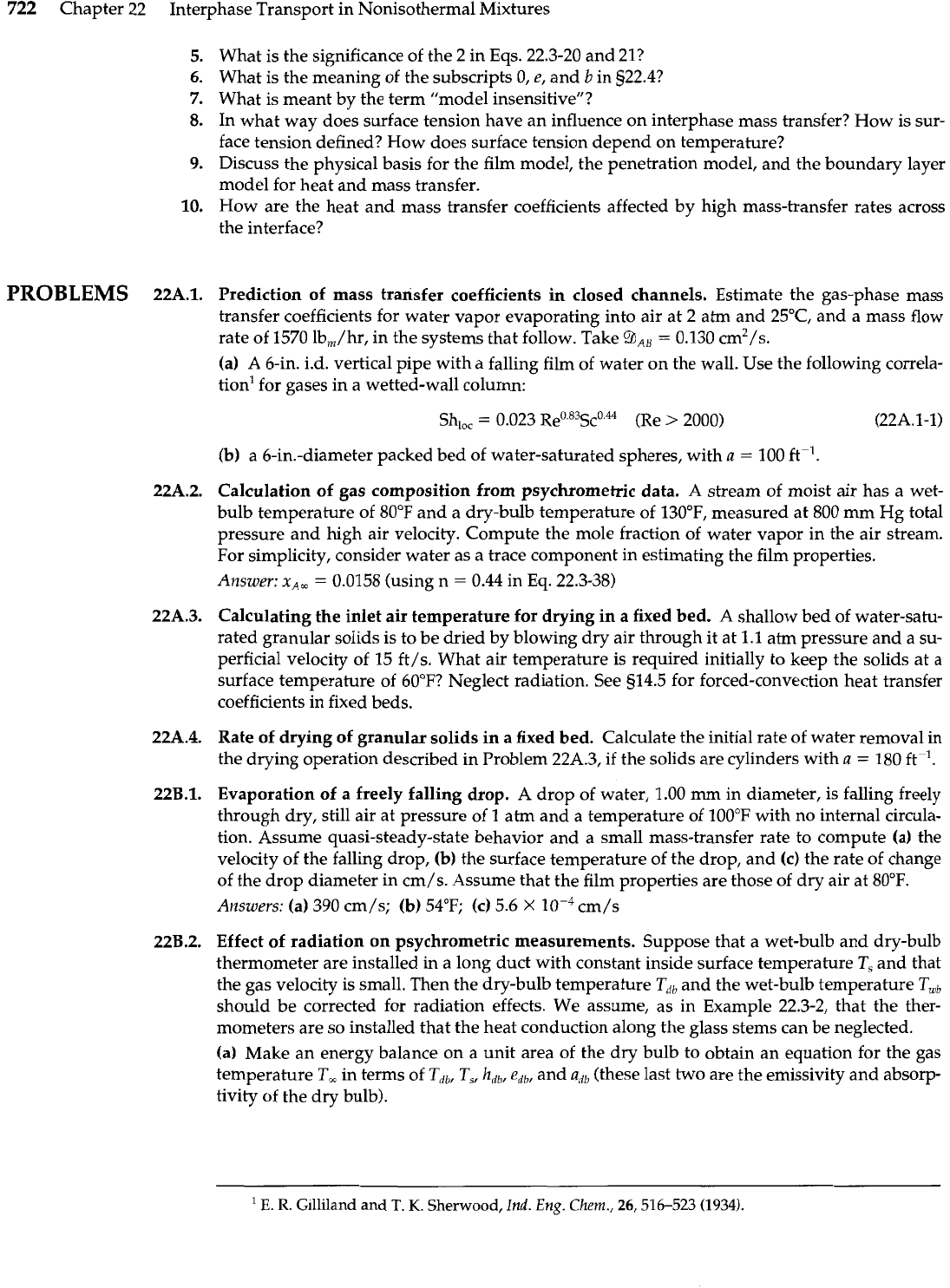
722
Chapter 22 Interphase Transport in Nonisothermal Mixtures
PROBLEMS
22~.1.
What is the significance of the 2 in Eqs. 22.3-20 and 21?
What is the meaning of the subscripts 0,
e,
and
b
in §22.4?
What is meant by the term "model insensitive"?
In what way does surface tension have an influence on interphase mass transfer? How is sur-
face tension defined? How does surface tension depend on temperature?
Discuss the physical basis for the film model, the penetration model, and the boundary layer
model for heat and mass transfer.
How are the heat and mass transfer coefficients affected by high mass-transfer rates across
the interface?
Prediction of mass transfer coefficients in closed channels. Estimate the gas-phase mass
transfer coefficients for water vapor evaporating into air at 2 atm and
25"C,
and a mass flow
rate of 1570 IbJhr, in the systems that follow. Take
a,,
=
0.130 cm2/s.
(a) A 6-in. i.d. vertical pipe with a falling film of water on the wall. Use the following correla-
tion' for gases in a wetted-wall column:
Sh,,,
=
0.023 Re0.83~~0.44 (Re
>
2000) (22A.1-1)
(b) a 6-in.-diameter packed bed of water-saturated spheres, with
a
=
100
W'
Calculation of gas composition from psychrometric data.
A
stream of moist air has a wet-
bulb temperature of 80°F and a dry-bulb temperature of 130°F, measured at 800 mm Hg total
pressure and high air velocity. Compute the mole fraction of water vapor in the air stream.
For simplicity, consider water as a trace component in estimating the film properties.
Answer
x,,
=
0.0158 (using n
=
0.44 in
Eq.
22.3-38)
Calculating the inlet air temperature for drying in a fixed bed. A shallow bed of water-satu-
rated granular solids is to be dried by blowing dry air through it at 1.1 atm pressure and a su-
perficial velocity of 15 ft/s. What air temperature is required initially to keep the solids at a
surface temperature of 60"F? Neglect radiation. See 514.5 for forced-convection heat transfer
coefficients in fixed beds.
Rate of drying of granular solids in a fixed bed. Calculate the initial rate of water removal in
the drying operation described in Problem 22A.3, if the solids are cylinders with
a
=
180 ft-l.
Evaporation of a freely falling drop. A drop of water, 1.00 mm in diameter, is falling freely
through dry, still air at pressure of
1
atm and a temperature of 100°F with no internal circula-
tion. Assume quasi-steady-state behavior and a small mass-transfer rate to compute (a) the
velocity of the falling drop, (b) the surface temperature of the drop, and (c) the rate of change
of the drop diameter in cm/s. Assume that the film properties are those of dry air at 80°F.
Answers: (a) 390 cm/s; (b) 54°F; (c) 5.6
X
W4
cm/s
Effect of radiation on psychrometric measurements. Suppose that a wet-bulb and dry-bulb
thermometer are installed in a long duct with constant inside surface temperature
T,
and that
the gas velocity is small. Then the dry-bulb temperature Tdb and the wet-bulb temperature TWb
should be corrected for radiation effects. We assume, as in Example 22.3-2, that the ther-
mometers are so installed that the heat conduction along the glass stems can be neglected.
(a) Make an energy balance on a unit area of the dry bulb to obtain an equation for the gas
temperature T, in terms of T,,,
T,,
h,,,
e,,, and adb (these last two are the emissivity and absorp-
tivity of the dry bulb).
'
E.
R.
Gilliland and
T.
K.
Sherwood,
Ind.
Eng.
Chem.,
26,516-523 (1934).
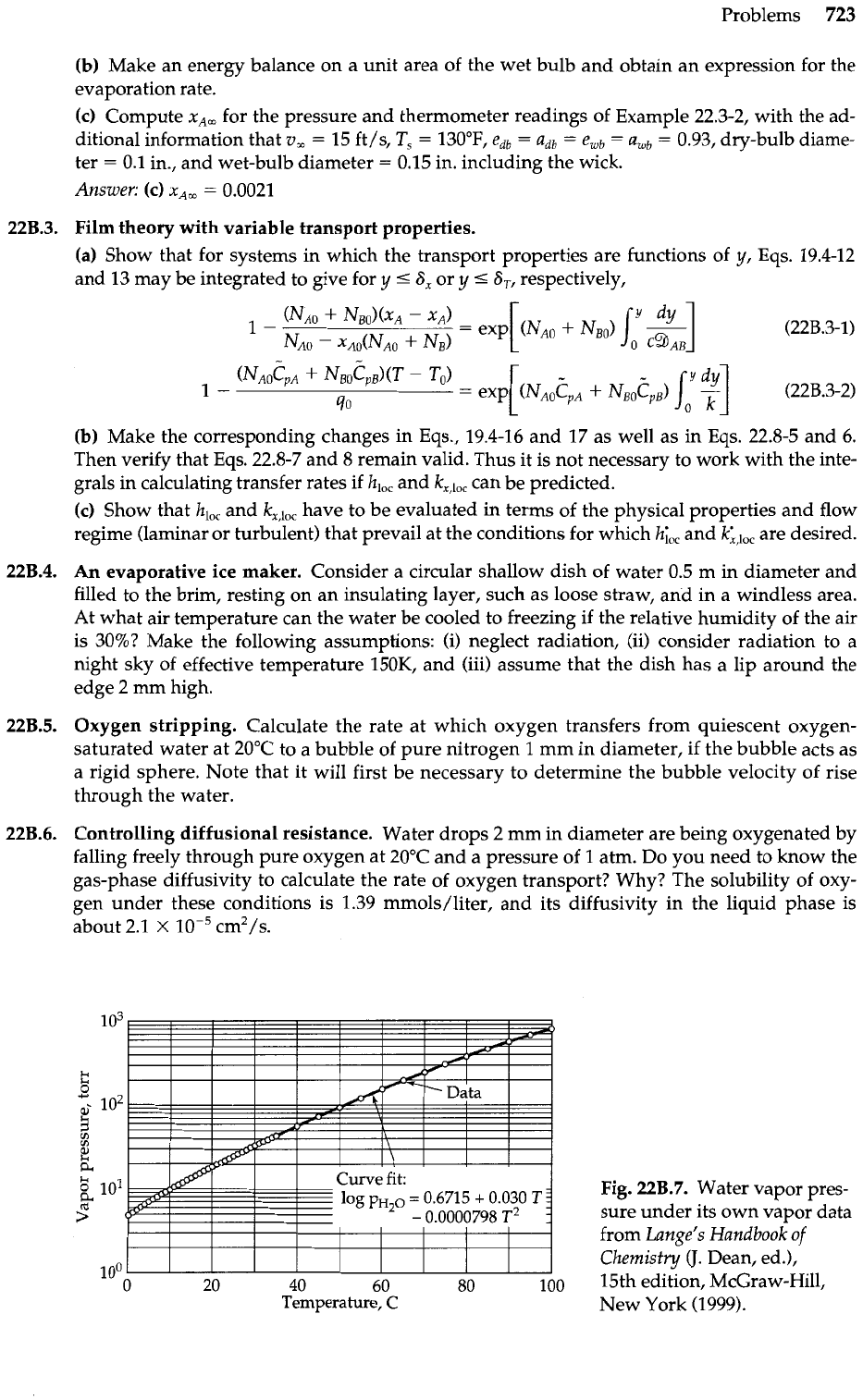
Problems
723
(b) Make an energy balance on a unit area of the wet bulb and obtain an expression for the
evaporation rate.
(c)
Compute
x,,
for the pressure and thermometer readings of Example 22.3-2, with the ad-
ditional information that
v,
=
15 ft/s,
T,
=
130°F,
edb
=
adb
=
eWb
=
aWb
=
0.93, dry-bulb diame-
ter
=
0.1 in., and wet-bulb diameter
=
0.15 in. including the wick.
Answer:
(c)
xAm
=
0.0021
22B.3.
Film theory with variable transport properties.
(a) Show that for systems in which the transport properties are functions of
y,
Eqs. 19.4-12
and 13 may be integrated to give for
y
a
6,
or
y
5
6,
respectively,
(b) Make the corresponding changes in Eqs., 19.4-16 and
17
as well as in Eqs. 22.8-5 and
6.
Then verify that Eqs. 22.8-7 and
8
remain valid. Thus it is not necessary to work with the inte-
grals in calculating transfer rates if
hloc
and
kX,,,,
can be predicted.
(c)
Show that
h,,,
and
kx,loc
have to be evaluated
in
terms of the physical properties and flow
regime (laminar or turbulent) that prevail at the conditions for which
hi,,
and
k&,
are desired.
22B.4.
An evaporative ice maker. Consider a circular shallow dish of water 0.5 m in diameter and
filled to the brim, resting on an insulating layer, such as loose straw, and in a windless area.
At what air temperature can the water be cooled to freezing if the relative humidity of the air
is 30%? Make the following assumptions: (i) neglect radiation, (ii) consider radiation to a
night sky of effective temperature 150K, and (iii) assume that the dish has a lip around the
edge 2 mm high.
228.5.
Oxygen stripping. Calculate the rate at which oxygen transfers from quiescent oxygen-
saturated water at 20°C to a bubble of pure nitrogen
1
mm in diameter, if the bubble acts as
a rigid sphere. Note that it will first be necessary to determine the bubble velocity of rise
through the water.
22B.6.
Controlling diffusional resistance. Water drops 2 mm in diameter are being oxygenated by
falling freely through pure oxygen at 20°C and a pressure of
1
atm. Do you need to know the
gas-phase diffusivity to calculate the rate of oxygen transport? Why? The solubility of oxy-
gen under these conditions is 1.39 mmols/liter, and its diffusivity in the liquid phase is
about 2.1
x
cm2/s.
Curve
fit:
log
~H~O
=
0.6715
+
0.030
T
-
0.0000798
T'
Fig.
22B.7.
Water vapor pres-
sure under its own vapor data
from
Lange's Handbook of
Chemistry
0.
Dean, ed.),
15th edition, McGraw-Hill,
Temperature,
C
New York (1999).

724
Chapter 22 Interphase Transport in Nonisothermal Mixtures
22B.7. Determination of diffusivity (Fig. 22B.7). The diffusivity of water vapor in nitrogen is to be
determined at a pressure of 1 atm over the temperature range from 0°C to 100°C by means of
the "Arnold experiment" of Example 20.1-1. It will, therefore, be necessary to use the correc-
tion factor
OA,
to the penetration model. Calculate this factor as a function of temperature. The
vapor pressure of water in this range may be obtained from Fig. 22B.7 or calculated from
where
p~~~
is the vapor pressure in mm Hg, and
T
is the temperature in degrees centigrade.
22B.8. Marangoni effects in condensation of vapors. In many situations the heat transfer coeffi-
cient for condensing vapors is given as
h
=
k/S,
where
k
is the thermal conductivity of the
condensate film, and 6 is the film thickness. Correlations available in the literature are nor-
mally based on the assumption of zero shear stress at the free surface of the film, but if the
surface temperature decreases downward, there will be a shear stress
7,
=
duldz, where u is
the surface tension, and
z
is measured downward, that is, in the direction of flow. How much
will this effect change a heat transfer coefficient of 5000 kcal/hr
m2
.
C for a water film? The
kinematic viscosity of water may be assumed to be 0.0029 cm2/s, the density is 0.96 g/cm3,
the thermal conductivity 0.713 kcal/hr. m
.
C, and
du/dT
=
-0.2 dynes/cm
C
for the pur-
poses of this problem.
(p:i2)(
3
b
)
Partial Answer:
p(v,)
=
-
I+--
2
P@
The term in
.r,
represents the effect of surface tension gradients, and when this term is
small, its denominator will be near the value for no gradient. For the conditions of this prob-
lem, pg6
=
14.3 dyn/cm2. Surface tension effects will thus be small for systems such as the
one under consideration, where the surface tension increases downward. In the opposite
case, however, even small gradients can cause hydrodynamic instabilities and thus can
have major effects.
22B.9. Film model for spheres. Derive the results that correspond to Eqs. 22.8-3,4 for simultaneous
heat and mass transfer in a system with spherical symmetry. That is, assume a spherical mass
transfer surface and assume that
T
and
XA
depend only on the radial coordinate
r.
Show that
Eqs. 22.8-7 and 8 do not need to be changed. What difficulties would be encountered if one
tried to use the film theory to calculate the drag on a sphere?
22B.10. Film model for cylinders. Derive the results that correspond to Eqs. 22.8-3,
4
for a system
with cylindrical symmetry. That is, assume a cylindrical mass transfer surface and assume
that
T
and
XA
depend only on
r.
Verify that Eqs. 22.8-7,8 do not need to be changed.
22C.1. Calculation of ultrafiltration rates. Check the accuracy of the predictions shown in Fig. 22.8-9
for the following data and physical properties:
Physical system:
Rotation rate of disk filter
=
273 rpm
Bovine serum albumin at p,
=
2.2 g/100 ml
Diffusivity in phosphate buffer (at pH 6.7)
=
7.1
X
cm2/s
Kinematic viscosity of buffer
=
0.01 cm2/s
Partial specific volumes of protein and buffer are 0.75 and 1.00 ml/g, respectively
Hydraulic permeability,
KH
=
0.0098 cm/min psi
Effect of protein concentration:
Solution density p
=
0.997
+
0.224~~ in g/ml
Protein-buffer diffusivity ratio '9ps(0)/9ps(pp)
=
21.34,/tanh(21.34$, where
4,
=
w~~~/(w~+~
+
uses)
is the volume fraction of protein, with
cp
and
Vs
being the par-
tial specific volumes of protein and solvent
Protein-buffer viscosity ratio ~(O)/p(p,)
=
1.11
-
0.054p,
+
0.00067p$, with pp in g/100 ml
Osmotic pressure
.rr
=
0.013& in psi (100 rnl/g)'
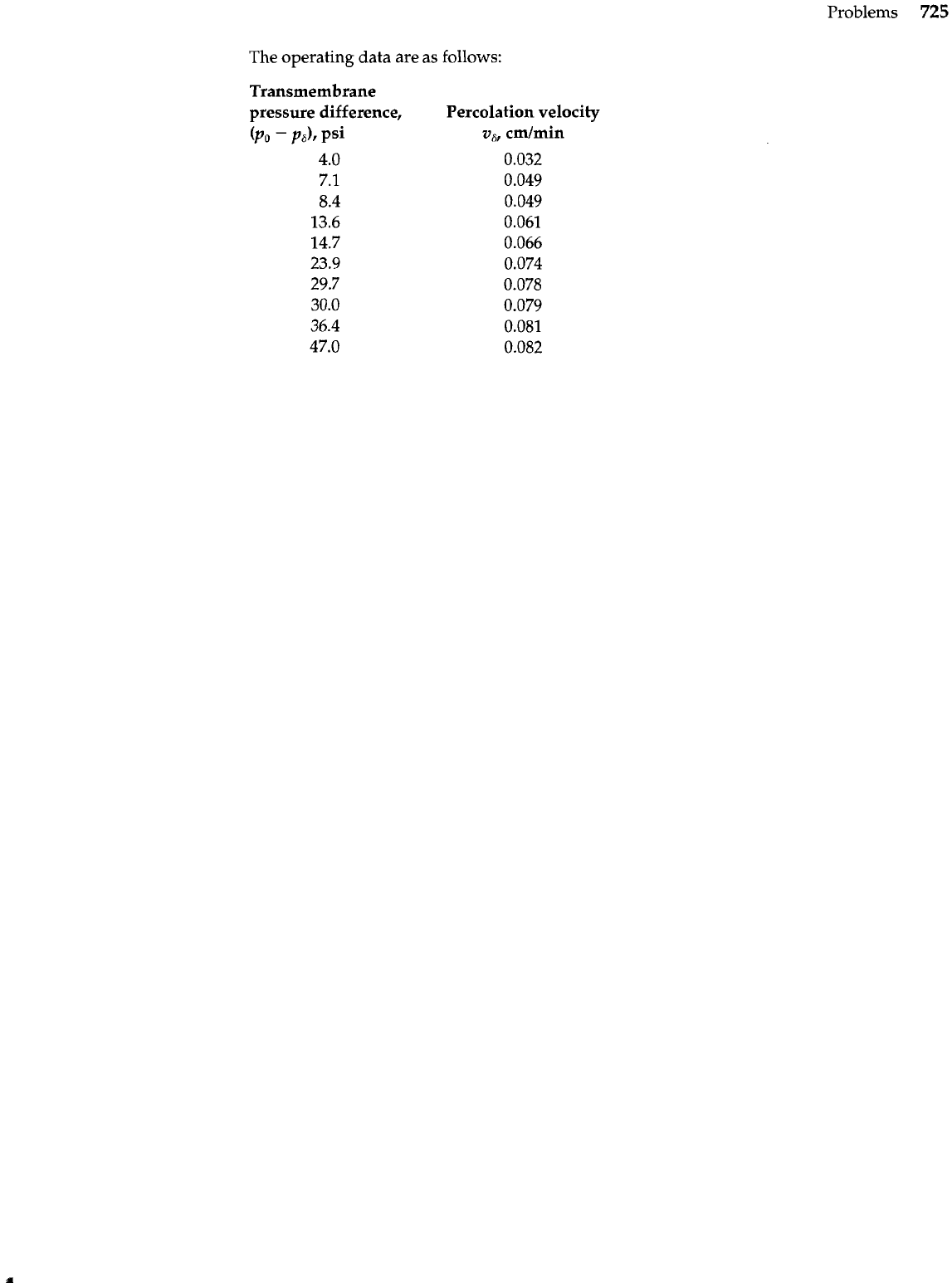
Problems
725
The operating data are as follows:
Transmembrane
pressure difference,
(PO
-
psh
psi
4.0
Percolation velocity
vfir
cmlmin
0.032
0.049
0.049
0.061
0.066
0.074
0.078
0.079
0.081
0.082
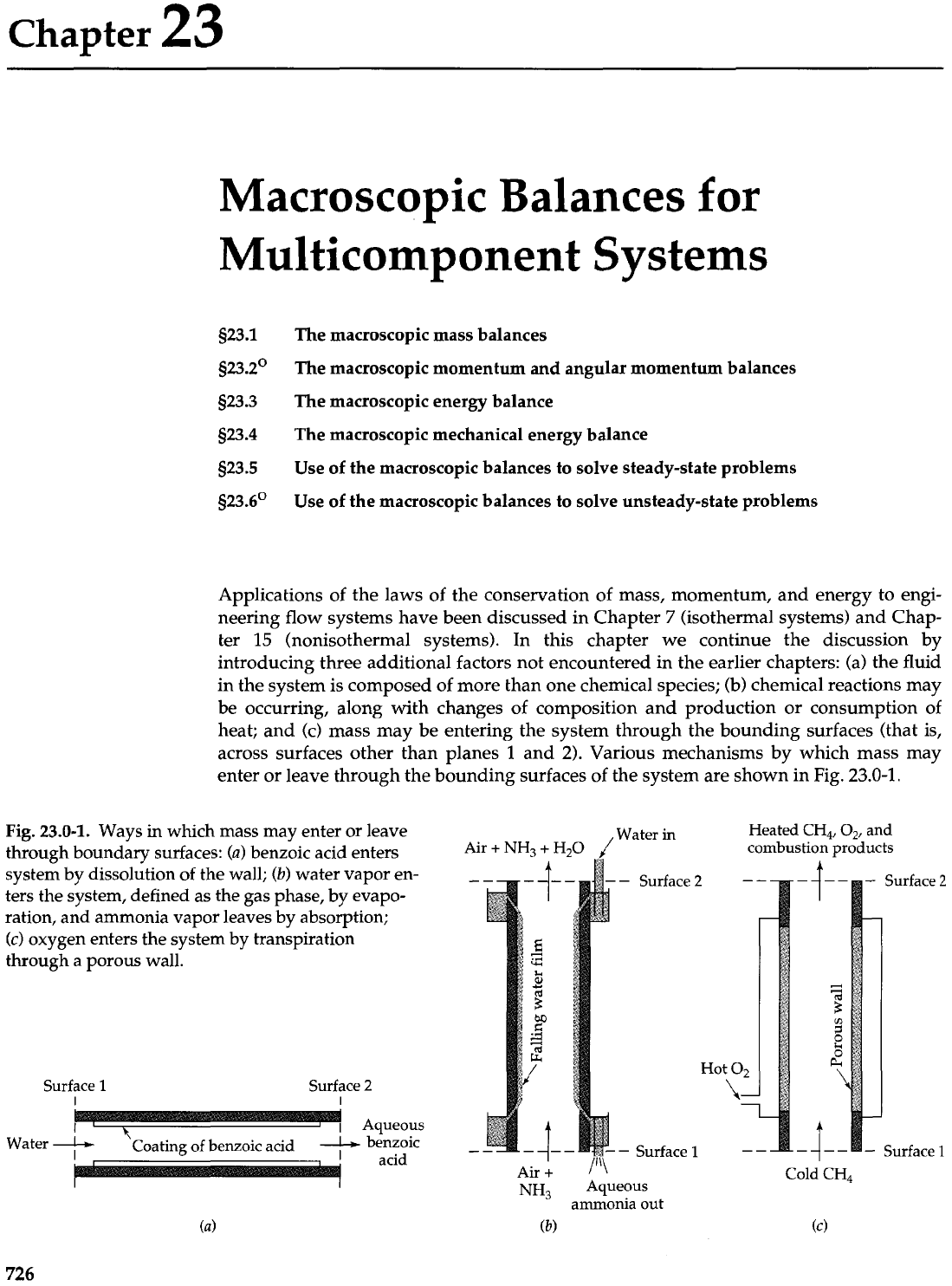
Chapter
23
Macroscopic Balances
for
Multicomponent
Systems
523.1 The macroscopic mass balances
523.2' The macroscopic momentum and angular momentum balances
523.3 The macroscopic energy balance
523.4 The macroscopic mechanical energy balance
523.5
Use of the macroscopic balances to solve steady-state problems
523.6O Use of the macroscopic balances to solve unsteady-state problems
Applications of the laws of the conservation of mass, momentum, and energy to engi-
neering flow systems have been discussed in Chapter
7
(isothermal systems) and Chap-
ter
15
(nonisothermal systems). In this chapter we continue the discussion by
introducing three additional factors not encountered in the earlier chapters: (a) the fluid
in the system is composed of more than one chemical species;
(b)
chemical reactions may
be occurring, along with changes of composition and production or consumption of
heat; and (c) mass may be entering the system through the bounding surfaces (that is,
across surfaces other than planes
1
and
2).
Various mechanisms by which mass may
enter or leave through the bounding surfaces of the system are shown in Fig.
23.0-1.
Fig. 23.0-1. Ways in which mass may enter or leave
Water
in
Heated
CH4,
4,
and
through boundary surfaces:
(a)
benzoic acid enters
Air
+
NH,
+
H,O
,/
combustion products
system
by
dissolution of the wall;
(b)
water vapor en-
-
-
Surface
2
ters the system, defined as the gas phase, by evapo-
ration, and ammonia vapor leaves by absorption;
(c)
oxygen enters the system by transpiration
through a porous wall.
Ho
Surface
1
Surface
2
Aqueous
Water benzoic
-
Surface
1
acid
Cold
CH4
NH~
Aqueous
ammonia
out
(a)
(b)
(4
Surface
2
Surface
1
